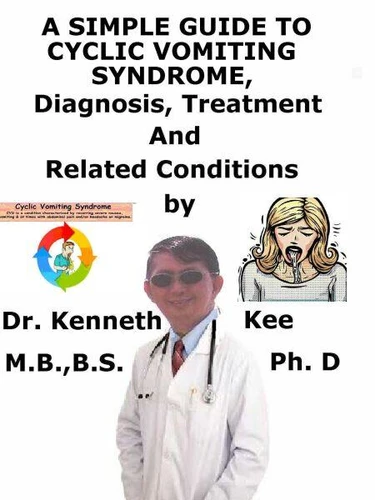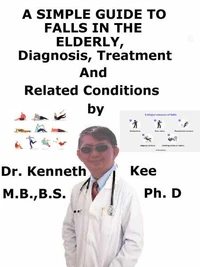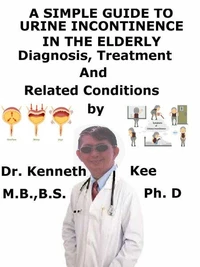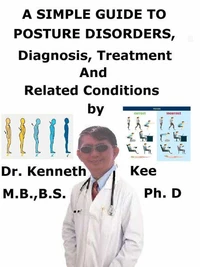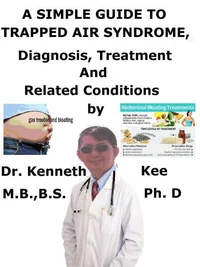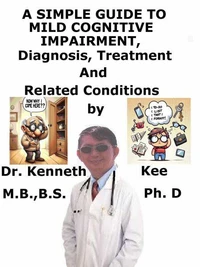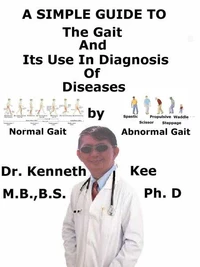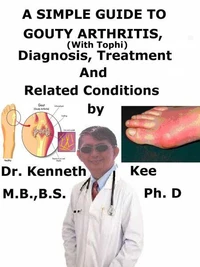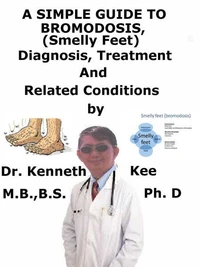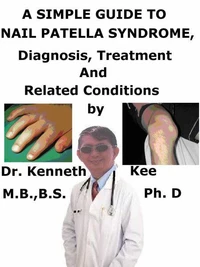A Simple Guide to Cyclic Vomiting Syndrome, Diagnosis, Treatment and Related Conditions
Par :Formats :
Disponible dans votre compte client Decitre ou Furet du Nord dès validation de votre commande. Le format ePub est :
- Compatible avec une lecture sur My Vivlio (smartphone, tablette, ordinateur)
- Compatible avec une lecture sur liseuses Vivlio
- Pour les liseuses autres que Vivlio, vous devez utiliser le logiciel Adobe Digital Edition. Non compatible avec la lecture sur les liseuses Kindle, Remarkable et Sony
 , qui est-ce ?
, qui est-ce ?Notre partenaire de plateforme de lecture numérique où vous retrouverez l'ensemble de vos ebooks gratuitement
Pour en savoir plus sur nos ebooks, consultez notre aide en ligne ici
- FormatePub
- ISBN8215215647
- EAN9798215215647
- Date de parution16/07/2023
- Protection num.pas de protection
- Infos supplémentairesepub
- ÉditeurWMG Publishing
Résumé
This book describes Cyclic Vomiting Syndrome, Diagnosis and Treatment and Related DiseasesCyclic vomiting syndrome (CVS) is a rare disorder characterized by recurrent episodes of severe vomiting that occur at regular intervals over an extended period of time. The disorder primarily affects children but can also occur in adults. Cyclic vomiting syndrome is a functional gastrointestinal disorder (no apparent cause) that causes sudden, repeated attacks (episodes) of severe nausea, vomiting and tiredness (lethargy).
Separating these attacks are periods without nausea or vomiting. The periods separating these episodes can be a few weeks to several months. Episodes can happen regularly or at random. Episodes can be so severe that the person may have to stay in bed for days, unable to go to school or work or may need treatment at an emergency room or a hospital during episodes. These episodes occur at regular intervals, often in a cyclical pattern, with symptom-free periods in between.
The underlying causes of CVS are not well known, but there are several factors that may contribute to the development of the condition. These factors are:Genetic predisposition (a family history of migraines), Abnormal brain function, Autonomic nervous system dysfunction, Digestive problems, Hormonal imbalances (menstruation, pregnancyCold allergies, Overeating, fastingAnxiety and stress, Cannabis abuseMany doctors believe that cyclic vomiting syndrome is a migraine-like disorder, which indicates that it is linked to changes in signaling between nerve cells in certain areas of the brain.
Many cases of CVS (28%) in children progresses to Migraine states in adults. Several alterations in mitochondrial DNA have been linked with cyclic vomiting syndrome. It is unclear how alterations in mitochondrial function could induce episodes of nausea, vomiting, and lethargy, abdominal pain or migraines in people with this disorder. Many affected persons have a family history of linked disorders, such as migraines, irritable bowel syndrome, or depression, in their mothers and other maternal relatives.
The family history may indicate an inheritance pattern termed maternal inheritance or mitochondrial inheritance, which applies to genes contained in mtDNA. The main symptom of CVS is severe vomiting, accompanied by nausea, abdominal pain, and headaches. The vomiting episodes are often sudden and can last for hours or even days. Other symptoms that may occur during episodes are pallor (pale skin), fatigue, and dizziness, sensitivity to light or sound, and dehydration.
The episodes are the same, indicating that they are likely to begin at the same time of day (in the morning), to persist the same length of time, and happen with the same symptoms and intensityThe diagnosis is normally made based on the presence of recurrent, severe vomiting episodes with a characteristic pattern and the absence of other identifiable causes for the symptoms. The purpose of treatment in cyclic vomiting syndrome is to:Identify and avoid triggering factors, Manage symptomsStop acute episodes with abortive treatment and supportive careIt often requires a combination of medicines and lifestyle modifications.
Lifestyle modifications may involve stress management techniques, dietary alterations, regular sleep patterns, and avoiding triggersMedications such as anti-nausea drugs, anti-migraine medicines, and proton pump inhibitors may alleviate symptoms and prevent episodesTABLE OF CONTENTIntroductionChapter 1 Cyclical Vomiting SyndromeChapter 2 CauseChapter 3 SymptomsChapter 4 DiagnosisChapter 5 TreatmentChapter 6 PrognosisChapter 7 Vomiting or EmesisChapte...
Separating these attacks are periods without nausea or vomiting. The periods separating these episodes can be a few weeks to several months. Episodes can happen regularly or at random. Episodes can be so severe that the person may have to stay in bed for days, unable to go to school or work or may need treatment at an emergency room or a hospital during episodes. These episodes occur at regular intervals, often in a cyclical pattern, with symptom-free periods in between.
The underlying causes of CVS are not well known, but there are several factors that may contribute to the development of the condition. These factors are:Genetic predisposition (a family history of migraines), Abnormal brain function, Autonomic nervous system dysfunction, Digestive problems, Hormonal imbalances (menstruation, pregnancyCold allergies, Overeating, fastingAnxiety and stress, Cannabis abuseMany doctors believe that cyclic vomiting syndrome is a migraine-like disorder, which indicates that it is linked to changes in signaling between nerve cells in certain areas of the brain.
Many cases of CVS (28%) in children progresses to Migraine states in adults. Several alterations in mitochondrial DNA have been linked with cyclic vomiting syndrome. It is unclear how alterations in mitochondrial function could induce episodes of nausea, vomiting, and lethargy, abdominal pain or migraines in people with this disorder. Many affected persons have a family history of linked disorders, such as migraines, irritable bowel syndrome, or depression, in their mothers and other maternal relatives.
The family history may indicate an inheritance pattern termed maternal inheritance or mitochondrial inheritance, which applies to genes contained in mtDNA. The main symptom of CVS is severe vomiting, accompanied by nausea, abdominal pain, and headaches. The vomiting episodes are often sudden and can last for hours or even days. Other symptoms that may occur during episodes are pallor (pale skin), fatigue, and dizziness, sensitivity to light or sound, and dehydration.
The episodes are the same, indicating that they are likely to begin at the same time of day (in the morning), to persist the same length of time, and happen with the same symptoms and intensityThe diagnosis is normally made based on the presence of recurrent, severe vomiting episodes with a characteristic pattern and the absence of other identifiable causes for the symptoms. The purpose of treatment in cyclic vomiting syndrome is to:Identify and avoid triggering factors, Manage symptomsStop acute episodes with abortive treatment and supportive careIt often requires a combination of medicines and lifestyle modifications.
Lifestyle modifications may involve stress management techniques, dietary alterations, regular sleep patterns, and avoiding triggersMedications such as anti-nausea drugs, anti-migraine medicines, and proton pump inhibitors may alleviate symptoms and prevent episodesTABLE OF CONTENTIntroductionChapter 1 Cyclical Vomiting SyndromeChapter 2 CauseChapter 3 SymptomsChapter 4 DiagnosisChapter 5 TreatmentChapter 6 PrognosisChapter 7 Vomiting or EmesisChapte...
This book describes Cyclic Vomiting Syndrome, Diagnosis and Treatment and Related DiseasesCyclic vomiting syndrome (CVS) is a rare disorder characterized by recurrent episodes of severe vomiting that occur at regular intervals over an extended period of time. The disorder primarily affects children but can also occur in adults. Cyclic vomiting syndrome is a functional gastrointestinal disorder (no apparent cause) that causes sudden, repeated attacks (episodes) of severe nausea, vomiting and tiredness (lethargy).
Separating these attacks are periods without nausea or vomiting. The periods separating these episodes can be a few weeks to several months. Episodes can happen regularly or at random. Episodes can be so severe that the person may have to stay in bed for days, unable to go to school or work or may need treatment at an emergency room or a hospital during episodes. These episodes occur at regular intervals, often in a cyclical pattern, with symptom-free periods in between.
The underlying causes of CVS are not well known, but there are several factors that may contribute to the development of the condition. These factors are:Genetic predisposition (a family history of migraines), Abnormal brain function, Autonomic nervous system dysfunction, Digestive problems, Hormonal imbalances (menstruation, pregnancyCold allergies, Overeating, fastingAnxiety and stress, Cannabis abuseMany doctors believe that cyclic vomiting syndrome is a migraine-like disorder, which indicates that it is linked to changes in signaling between nerve cells in certain areas of the brain.
Many cases of CVS (28%) in children progresses to Migraine states in adults. Several alterations in mitochondrial DNA have been linked with cyclic vomiting syndrome. It is unclear how alterations in mitochondrial function could induce episodes of nausea, vomiting, and lethargy, abdominal pain or migraines in people with this disorder. Many affected persons have a family history of linked disorders, such as migraines, irritable bowel syndrome, or depression, in their mothers and other maternal relatives.
The family history may indicate an inheritance pattern termed maternal inheritance or mitochondrial inheritance, which applies to genes contained in mtDNA. The main symptom of CVS is severe vomiting, accompanied by nausea, abdominal pain, and headaches. The vomiting episodes are often sudden and can last for hours or even days. Other symptoms that may occur during episodes are pallor (pale skin), fatigue, and dizziness, sensitivity to light or sound, and dehydration.
The episodes are the same, indicating that they are likely to begin at the same time of day (in the morning), to persist the same length of time, and happen with the same symptoms and intensityThe diagnosis is normally made based on the presence of recurrent, severe vomiting episodes with a characteristic pattern and the absence of other identifiable causes for the symptoms. The purpose of treatment in cyclic vomiting syndrome is to:Identify and avoid triggering factors, Manage symptomsStop acute episodes with abortive treatment and supportive careIt often requires a combination of medicines and lifestyle modifications.
Lifestyle modifications may involve stress management techniques, dietary alterations, regular sleep patterns, and avoiding triggersMedications such as anti-nausea drugs, anti-migraine medicines, and proton pump inhibitors may alleviate symptoms and prevent episodesTABLE OF CONTENTIntroductionChapter 1 Cyclical Vomiting SyndromeChapter 2 CauseChapter 3 SymptomsChapter 4 DiagnosisChapter 5 TreatmentChapter 6 PrognosisChapter 7 Vomiting or EmesisChapte...
Separating these attacks are periods without nausea or vomiting. The periods separating these episodes can be a few weeks to several months. Episodes can happen regularly or at random. Episodes can be so severe that the person may have to stay in bed for days, unable to go to school or work or may need treatment at an emergency room or a hospital during episodes. These episodes occur at regular intervals, often in a cyclical pattern, with symptom-free periods in between.
The underlying causes of CVS are not well known, but there are several factors that may contribute to the development of the condition. These factors are:Genetic predisposition (a family history of migraines), Abnormal brain function, Autonomic nervous system dysfunction, Digestive problems, Hormonal imbalances (menstruation, pregnancyCold allergies, Overeating, fastingAnxiety and stress, Cannabis abuseMany doctors believe that cyclic vomiting syndrome is a migraine-like disorder, which indicates that it is linked to changes in signaling between nerve cells in certain areas of the brain.
Many cases of CVS (28%) in children progresses to Migraine states in adults. Several alterations in mitochondrial DNA have been linked with cyclic vomiting syndrome. It is unclear how alterations in mitochondrial function could induce episodes of nausea, vomiting, and lethargy, abdominal pain or migraines in people with this disorder. Many affected persons have a family history of linked disorders, such as migraines, irritable bowel syndrome, or depression, in their mothers and other maternal relatives.
The family history may indicate an inheritance pattern termed maternal inheritance or mitochondrial inheritance, which applies to genes contained in mtDNA. The main symptom of CVS is severe vomiting, accompanied by nausea, abdominal pain, and headaches. The vomiting episodes are often sudden and can last for hours or even days. Other symptoms that may occur during episodes are pallor (pale skin), fatigue, and dizziness, sensitivity to light or sound, and dehydration.
The episodes are the same, indicating that they are likely to begin at the same time of day (in the morning), to persist the same length of time, and happen with the same symptoms and intensityThe diagnosis is normally made based on the presence of recurrent, severe vomiting episodes with a characteristic pattern and the absence of other identifiable causes for the symptoms. The purpose of treatment in cyclic vomiting syndrome is to:Identify and avoid triggering factors, Manage symptomsStop acute episodes with abortive treatment and supportive careIt often requires a combination of medicines and lifestyle modifications.
Lifestyle modifications may involve stress management techniques, dietary alterations, regular sleep patterns, and avoiding triggersMedications such as anti-nausea drugs, anti-migraine medicines, and proton pump inhibitors may alleviate symptoms and prevent episodesTABLE OF CONTENTIntroductionChapter 1 Cyclical Vomiting SyndromeChapter 2 CauseChapter 3 SymptomsChapter 4 DiagnosisChapter 5 TreatmentChapter 6 PrognosisChapter 7 Vomiting or EmesisChapte...

